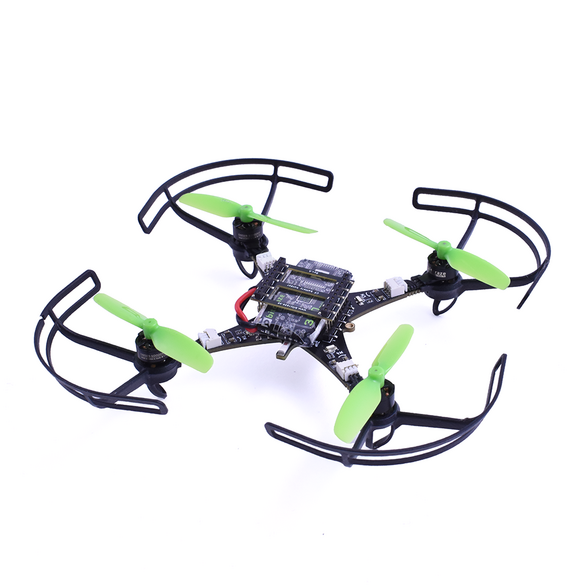CrazySim2Real is a comprehensive framework for evaluating control algorithms on Crazyflie quadcopters, providing a standardized testing environment that bridges the gap between simulation and real hardware. This repository contains two main components:
- A physics-based Crazyflie drone simulator built on NVIDIA Isaac Lab
- A benchmarking framework for evaluating controller performance in both simulation and real-world environments
CrazySim2Real/
├── crazyflie_benchmark/ # Benchmarking framework for controller evaluation
│ ├── config/ # Configuration files for hardware and simulator
│ ├── logs/ # Test result logs (both sim and real)
│ ├── test_plans/ # Predefined test plans (step, impulse, sine sweep)
│ └── tests/ # Test implementation modules
├── crazyflie_sim/ # Simulator implementation
│ ├── api/ # API server for simulator control
│ ├── controllers/ # Controller implementations for simulator
│ └── sim/ # Simulation manager and physics implementation
├── docker/ # Docker configurations
│ └── isaaclab/ # Isaac Lab simulator environment
└── scripts/ # Utility scripts for setup and execution
- Unified Testing Interface: Run identical tests on both simulated drones and real hardware
- Standardized Test Protocols: Pre-defined step, impulse, and sine sweep test plans
- Data Collection & Analysis: Automated logging, metrics generation and visualization
- Physics-Based Simulation: High-fidelity drone simulation using NVIDIA Isaac Lab
- Configurable Controllers: Evaluate different control algorithms with minimal code changes
- Safety Monitoring: Built-in safety features to protect hardware during testing
- Docker Integration: Containerized simulation environment for consistent results
- Python 3.8+ with pip
- Docker and Docker Compose (for simulation)
- Crazyflie hardware and Crazyradio PA (for real hardware tests)
- NVIDIA GPU with latest drivers (for simulation)
-
Clone the repository:
git clone https://github.com/yourusername/CrazySim2Real.git cd CrazySim2Real -
Install the required Python dependencies:
pip install -r crazyflie_benchmark/requirements.txt
-
Set up the Isaac Lab Docker environment (only needed for simulation):
# First-time setup ./scripts/init.sh
The simulator runs in a Docker container with NVIDIA Isaac Lab:
# Start the simulator
./scripts/start.sh /isaaclab/CrazySim2Real/crazyflie_sim/run.py
# Alternative with custom parameters
./scripts/start.sh /isaaclab/CrazySim2Real/crazyflie_sim/run.py --port 8000This will start a Docker container with the Isaac Lab environment and launch the Crazyflie simulator inside it. The simulator exposes an HTTP API that the benchmarking framework can connect to.
The benchmarking framework can run tests on either the simulator or real hardware:
# List available test plans
cd crazyflie_benchmark
python main.py --list-tests
# Run a benchmark in simulation
python main.py --config config/simulator_config.yaml --test-plan test_plans/step_tests.yaml
# Run a benchmark on real hardware
python main.py --config config/hardware_config.yaml --test-plan test_plans/step_tests.yamlTest plans are defined in YAML files in the test_plans/ directory:
- Step Tests (
step_tests.yaml): Evaluates the system's response to step inputs in roll, pitch, and thrust - Impulse Tests (
impulse_tests.yaml): Measures disturbance rejection and stability - Sine Sweep Tests (
sine_sweep_tests.yaml): Evaluates frequency response characteristics
Example step test configuration:
name: "Step Response Tests"
description: "Step response tests for roll, pitch, and thrust axes."
tests:
- type: "step"
channel: "roll"
amplitude: 5.0 # degrees
duration: 1.5 # seconds
- type: "step"
channel: "pitch"
amplitude: 5.0 # degrees
duration: 1.5 # secondsTest results are automatically logged in the logs/ directory, with separate folders for simulation and real hardware tests. The framework provides tools for analyzing and visualizing test results:
# Analyze a specific test run
python main.py --analyze logs/20250513_001722-step-real/
# Generate plots and metrics
python main.py --analyze logs/20250513_001722-step-real/ --plots --metricsThe framework enables direct comparison between simulation and real hardware performance:
# Compare sim and real tests
python main.py --compare logs/sim/20250513_005534-step-sim/ logs/real/20250513_001722-step-real/This will generate comparative metrics and plots showing the differences between simulation and reality.
Configuration files specify connection parameters and flight settings:
connection_type: "cflib" # Use real Crazyflie hardware
uri: "radio://0/80/2M/E7E7E7E7E6" # Radio URI for your Crazyflie
hover_thrust: 40000 # Approximate hover thrust (0-65535 scale)
max_roll_pitch: 15.0 # Safety limit for roll/pitch angle (degrees)connection_type: "simulator" # Use simulator
sim_host: "localhost" # Simulator host address
sim_port: 8000 # Simulator port
hover_thrust: 0.6 # Approximate hover thrust (normalized 0-1 scale)
max_roll_pitch: 15.0 # Safety limit for roll/pitch angle (degrees)Contributions are welcome! Please feel free to submit a Pull Request.
This project is licensed under the MIT License - see the LICENSE file for details.
- Bitcraze for the Crazyflie platform
- NVIDIA Isaac Lab for the simulation environment

